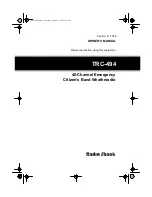
RAWS-H Remote Automated Weather Station
batteries connected. The battery connections are diode isolated; however, if
one of the batteries fails, it could draw all the charging current and the other
battery will be discharged.
Reversal of battery polarity will damage the CH100 or
battery.
It is possible to leave two batteries connected. The battery
connections are diode isolated; however, if one of the
batteries fails, it could draw all the charging current and the
other battery will be discharged.
5.3.3 Troubleshooting, Battery
Measure the +12 V and Ground terminal on the CR1000 printed circuit board
wiring panel. Acceptable readings are +11 VDC to +14 VDC. Use PC200W
software to collect the 1-HR data table from the CR1000 datalogger and review
the historical record of battery voltage.
5.4 GOES Transmitter
5.4.1 General Description, GOES Transmitter (part #TX320)
The High Data Rate GOES transmitter (part #TX320)
shown in Figure 5.4-1
supports one-way communication, via satellite, from a Campbell Scientific
datalogger to a ground receiving station. Satellite telemetry offers a convenient
communication alternative for field stations where phone systems or RF
systems are impractical or rendered unreliable after a tragedy to the local
infrastructure. Data transmission rates of 100, 300, and 1200 bps are
supported. Because clock accuracy is critically important for GOES satellite
telemetry, the TX320 includes a robust, TCXO-based real-time clock and a
GPS receiver.
The TX320 transmitter has two siting requirements for proper operation. The
GOES antenna must have a clear view of the spacecraft. The GOES antenna is
directional and should be aimed at the spacecraft. Both elevation and azimuth
are unique to the location of the planet and must be set. A poorly aimed
antenna will cause a drop in signal strength or possibly prevent successful
transmission.
For more information on the GOES transmitter (part #TX320)
and antenna
siting, go to our website at
www.campbellsci.com
, enter the “TX320” in the
“Search” box on the website mentioned above, and go the equipment manual.
The GOES transmitter (part #TX320)
manual is also provided on the
ResourceDVD which ships with the RAWS Quick Deployment Weather
Station.
The spacecraft specific DCP-Setup parameters for the GOES
transmitter must be entered in the CR1000 program.
NOTE
CAUTION
WARNING
9
















































